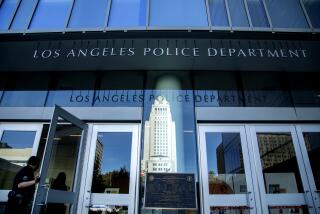Police Panel Urges Steps to Fight Gangs
Responding to calls for action against the sprawling 18th Street gang, the Los Angeles Police Commission on Tuesday recommended a laundry list of new tools--ranging from expanded witness protection to delinquency prevention and after-school programs--to curb gang-related crime.
The wish list carried no price tag and still must weather debate and be approved by the City Council, and in some cases, the Legislature. But it represented one of the more focused efforts by the Los Angeles Police Department to lay out a comprehensive strategy for reducing the mayhem attributed to the city’s more than 400 street gangs.
As the violent crime rate has dropped in Los Angeles, gang violence has remained at alarming levels, law enforcement officials say. While gang homicides finally dipped in 1996, they still accounted for more than 40% of all Los Angeles County slayings. That is double the share of gang-related killings in 1985.
The LAPD’s package of proposals looks beyond traditional law enforcement measures, acknowledging a complex legacy of social and economic ills that have fueled the gang culture for more than 40 years.
*
The report responds to a City Council request last year, on the heels of a series in The Times chronicling the violent spread of 18th Street, the region’s largest gang. It comes as City Atty. James K. Hahn is seeking a sweeping court injunction against one clique of the gang accused of terrorizing a Southwest Los Angeles neighborhood.
Saying that “a lot of different kinds of kids” are being drawn into the orbit of gangs, Police Commission President Raymond C. Fisher added that the city’s anti-gang efforts must distinguish between hard-core violent offenders and young wannabes on the fringes of gang life. “It’s not just a question of busting the bad guys,” he said, adding that alternatives to gangs should be provided to teens.
Among the proposed measures: new state laws requiring police, education and social service agencies to share information on troubled juveniles; expanded city recreation and job programs to target youths at risk of being recruited by gangs; more interagency police task forces zeroing in on the most violent gangs, and more probation officers and crime analysts to work directly with LAPD anti-gang units.
The report also seeks additional funding for informants and witness protection programs, as well as increased support for community members who “demonstrate the courage to stand up to gang violence.” Moreover, state legislation is needed to broaden wiretap laws to cover increasingly sophisticated criminal gang activities, the report said.
Unaddressed was one of the more controversial aspects of gang enforcement--dealing with illegal immigrants. At the hearing Tuesday, Hollywood neighborhood activist Joe Shea criticized the panel for failing to confront the politically volatile issue.
According to a confidential state Department of Justice report on 18th Street cited in The Times series, illegal immigrants account for 50% to 60% of the gang’s Southern California membership, estimated to be as high as 20,000.
Residents in gang-blighted areas want gang members who are here illegally to be deported, according to Shea. “If they are [illegal], they want them out,” he told the commission.
For nearly 20 years, the LAPD has operated under its Special Order 40, which prevents officers from initiating immigration checks in routine contacts and turning over minor offenders to the Immigration and Naturalization Service.
It was adopted because of concerns that the city’s large numbers of new arrivals--many lacking legal documents or coming from countries where police were linked to death squads--would fail to report crime for fear of being deported.
On Tuesday, the LAPD’s gang czar, Deputy Chief John White, said the department recently reexamined the policy and concluded that it does not hinder anti-gang operations. “Throwing every illegal out of the country,” White said, “is not going to solve those problems.”
*
The Police Commission’s action plan even drew guarded praise from the American Civil Liberties Union. Still, a spokesman warned the panel that a bid by the LAPD to join a new statewide, computerized tracking system of gang members must be carefully monitored to avoid stigmatizing innocent people.
Many law enforcement agencies across the state do not have the same standards as the LAPD for entering alleged gang members into the database, the spokesman said.
Despite its wide range of proposals, the report came with a sobering caveat from White. “Gangs have been here since the ‘30s,” he said. “They are not going to go away. They are part of society.”
More to Read
Sign up for Essential California
The most important California stories and recommendations in your inbox every morning.
You may occasionally receive promotional content from the Los Angeles Times.











